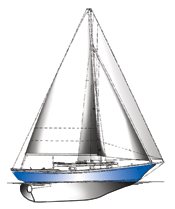Classic 30
2008 November 5
Traditional cruiserr
This model is a big brother to the Eastsail 25 and very much in the same style. I would have liked to see a little more "kick" to the sheerline aft but sheers are personal matters of taste. The clipper bow is always a favorite with traditionalists and in this context looks great. With a clipper bow you get trailboards and the opportunity for some fancy gold leaf scrollwork. This is a full keel but it is slightly cut away forward and that will help with maneuverability and feel. The D/L is only 197. This is light for a boat with a keel like this. The plan view shows moderately full ends. Draft is only 4 feet, 6 inches, so if you live in a skinny-water area this may be your next boat. The L/B is 2.98.
 There is a lot you can do with the interior layout of a 31-foot, 4-inch boat. But I like the old, traditional layouts the best. Start with the idea that you will probably cruise this boat with two people, maybe one. The Classic 30 could accommodate four overnight if you use the starboard settee/berth. The galley stretches across the boat with the reefer on the starboard side and the sink to port. There is a short settee to port and a pilot berth outboard. This is kind of unusual and I might have preferred the galley to go farther outboard and this berth to be eliminated. But, pilot berths are great for guitars, sea bags and kids, and they always make great sea berths. The chart table folds down over the starboard settee. The head features one of those old-fashioned basins that hinges up against the bulkhead. There is a big hanging locker adjacent to the head. Forward, the V-berths are honest single berths that are designed to be used as singles, but I'm sure you could convert them to a double. Bringing the V-berths aft like this leaves plenty of room for a fo'c'sle. Two mates escaping the chilly drizzle could sit below in a kerosene lantern glow, hoist their glasses and toast a fine day of sailing while heating up lamb stew.
There is a lot you can do with the interior layout of a 31-foot, 4-inch boat. But I like the old, traditional layouts the best. Start with the idea that you will probably cruise this boat with two people, maybe one. The Classic 30 could accommodate four overnight if you use the starboard settee/berth. The galley stretches across the boat with the reefer on the starboard side and the sink to port. There is a short settee to port and a pilot berth outboard. This is kind of unusual and I might have preferred the galley to go farther outboard and this berth to be eliminated. But, pilot berths are great for guitars, sea bags and kids, and they always make great sea berths. The chart table folds down over the starboard settee. The head features one of those old-fashioned basins that hinges up against the bulkhead. There is a big hanging locker adjacent to the head. Forward, the V-berths are honest single berths that are designed to be used as singles, but I'm sure you could convert them to a double. Bringing the V-berths aft like this leaves plenty of room for a fo'c'sle. Two mates escaping the chilly drizzle could sit below in a kerosene lantern glow, hoist their glasses and toast a fine day of sailing while heating up lamb stew.This is a simple cutter rig. Some might argue that the mast location forward makes this really a sloop with a staysail but let's call it a cutter. The staysail hounds are high and the foot of the staysail is long, giving it good proportions. In a breeze this will be your working jib and with a double reef you will have a masthead-reduced rig and this little hooker will fly. I'm not keen on high-clewed yankees, so my preference for the headsail would be a 130-percent genoa with the clew about at the top lifeline. This genoa will make a fine reaching and running sail. The boom is long and this gets the traveler aft of the cockpit. This boat will not be a pointer and I would guess if you get everything trimmed just right you could expect an efficient on-the-wind apparent wind angle of 39 degrees. But with this hull form there is no sense in jamming the boat up any higher.
Having just returned from the Annapolis boat show I can tell you with confidence that we live in a "me too" world. The "bloated tennis shoe" look, as my pal Tom calls it, is everywhere. It's a pleasure to review a design by a designer and yard that have said, "We'll do it our way."

Comments